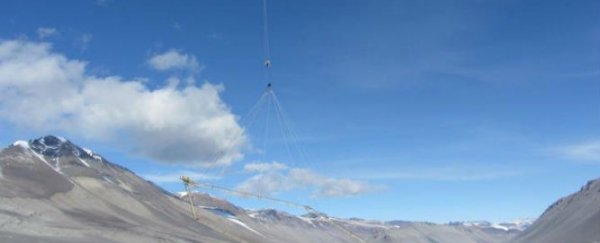There are a lot of different ways to look at our planet's warming climate – such as more extreme weather events, increasing levels of vegetation in the Arctic, and even shifting seasons.
Now we just got a new metric showing the severity of the situation.
A group of scientists have came together to discuss what we can learn about the environment by peering back into Earth's history.
Looking back to the last time Earth's atmosphere had this much carbon dioxide in it, the scene is rather dramatic: there were trees growing at the South Pole, sea levels were up to 20 metres (66 feet) higher, and global temperatures were 3-4°C above what they are today.
That paints a worrying picture about how much CO2 we've got in our air, and how our world might continue to change as temperatures go up.
Scientists from across the UK came together in a Royal Meteorological Society meeting on April 3 to discuss the most recent research in climate change, and how our distant past may soon come back to repeat itself.
One of the researchers, Jane Francis from the British Antarctic Survey, based her analysis on a finding of plant fossils and sedimentary records dating from the Pliocene epoch, between 5.3 million and 2.6 million years ago.
"This is an amazing discovery," she told The Guardian. "They found fossil leaves of southern beech. I call them the last forests of Antarctica."
"They were growing at 400 ppm [parts-per-million] CO2, so this may be where we are going back to, with ice sheets melting at times, which may allow plants to colonise again."
Last year the amount of carbon dioxide in our atmosphere reached 410 ppm, thought to be the highest level in the last 800,000 years. We're carrying on burning fossil fuels, and carbon dioxide keeps on building up.
So far we haven't seen the sea level and temperature rises of the Pliocene, or much in the way of vegetation at the South Pole, but that's the way we're heading – these new findings are another stark warning about our future, as if we needed one.
"If you put your oven on at home and set it to 200C, the temperature doesn't get to that level immediately," said Martin Siegert from Imperial College London in the UK, who chaired the discussion. "It takes a bit of time."
"And it's the same with Earth's climate. If you ratchet up the level of CO2 at 400 parts-per-million, it won't suddenly get to an equilibrium overnight. It will take maybe 300 years or something."
Polar regions are the most sensitive to climate change, and show the effects first – it's like an early warning system for our planet.
When it comes to the discovery of South Pole forests, the indications are that when these fossilised leaves were growing, there were no ice sheets in Greenland and west Antarctica.
Summertime temperatures in Antarctica would have been around 5 degrees Celsius (41 degrees Fahrenheit), compared with the -15 to -20 degrees Celsius (5 to -4 degrees Fahrenheit) they are today.
At the current rate of emissions, the researchers suggest, we could be up to 1,000 ppm of CO2 in the atmosphere. Drastic steps are needed to stop that from happening, otherwise we'll be back to the Pliocene era – or maybe even further.
While some aspects of the changing climate are now inevitable, a study earlier this year showed there could still be a chance to limit temperature rises, although the window is closing fast.
And scientists are staring down the barrel of this new climate reality, as emphasised by palaeoclimate scientist Alan Haywood from the University of Leeds.
"After studying the Pliocene for 21 years, and all things being equal in the decades ahead, I will experience first hand a climate state that has not existed for more than three million years," he said.
You can watch a recording of the meeting and view presentation abstracts here.
